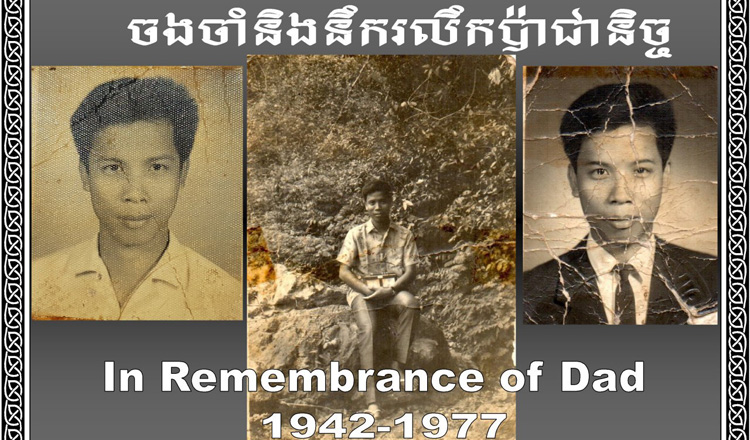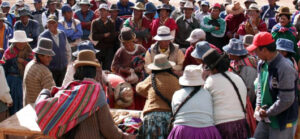Even though my family assumed that my father was killed in a cave in Sampov Mountain, I always yearned to know about the details surrounding his death. Whenever I read the news and saw photos of those who died during the Khmer Rouge era, I would always look at the photos one by one, on the off chance that my father was in one of them. But I never saw his face. I had no way of finding him because I had no idea where to start.
One day, I travelled to Phnom Penh with my friends and visited the Tuol Sleng Genocide Museum. It was my first time being there. I walked from one building to another, looking at the photographs and equipment that were used to torture the victims. I couldn’t help but feel a surge of emotions upon seeing proof of the atrocities that were committed there.
As I was walking around the area, I saw a memorial stupa. The names etched on the stones were those of the prisoners’, my friend said. Intrigued, I read through the names one by one. Suddenly, I came across two names that were identical to my father’s. The names stopped me in my tracks. I was confused, terrified. Before I knew it, tears were falling down my cheeks. At that moment, a painful realisation crossed my mind: if my father was imprisoned here, he would have been brutally tortured, too, as shown in the pictures.
However, I had no proof on hand to determine whether either of the names belonged to him. Upon returning home, I decided to publish my story on Facebook. Friends who read it told me to get in touch with the Documentation Centre of Cambodia, which conducts researches and keeps an archive of documents related to the Khmer Rouge. Soon after messaging the centre, I received a reply with three attached documents, one of which contained my father’s confession, which was extracted from him while he was being held prisoner. It was the only proof that I needed to confirm my father’s whereabouts from the time he disappeared.
When I told the family about my discovery, we were grief-stricken. We grieved for the man whom we lost and for the brutal death that met him in Tuol Sleng prison.
Finding my father
In the years that he had been gone, the possibility of my father being imprisoned in Tuol Sleng never crossed my mind. We decided to hold a religious ceremony in Tuol Sleng Genocide Museum and the Choeung Ek killing fields, praying that he would not go through such atrocities in his next reincarnation.
I read my father’s confession. I discovered a lot about him while doing so. He was born in Battambang province’s Russei Srok village in the Khpob commune of Mouy Phei district. He was a professor at Battambang High School before the Khmer Rouge regime took power.
During the genocidal era, he had to give up his life in the academia and was forced to become the leader of the mobile unit [for the Khmer Rouge] and the new people in the third collective in Ba Phnom district, Northwest Zone. His statement reminded me of a lot of the stories my mother used to tell me during the Khmer Rouge era. She also read the confession, saying she remembered some of the names that were mentioned there.
The Angkar also learned a lot about my father’s movements through the information he gave. To them, he was a traitor.
What follows is my father’s account of his life and story, which he gave during an interrogation by the Angkar at Tuol Sleng.
The preserved story of Srun Seng Hot
I studied at Wat Khpob Primary School from 1955 until I reached the 7th Grade. In 1961, I passed the entrance exam and continued my studies in Phnom Penh’s Technique High School. While there, I lived in a house that belonged to Pov Chhon, a former engineer from the Technique High School. In 1964, Pov Chhon started my induction to become a CIA agent by educating me about the prosperity that free countries, such as the United States of America, enjoy. He said the communist regime, as what China has, has led to a lot of pain and suffering.
As an agent, I was tasked to build a team, monitor Khmer Rouge activities and use propaganda to provoke the hatred of students toward the regime. Pov Chhon introduced me to two other CIA agents, Leng Siphon and Hing Tun, who were also alumni of the high school. At the time, the three of us carried out various activities, one of which was scattering pamphlets in Preah Monivong Boulevard, all of which contained messages against the Khmer Rouge and its inclination toward the communist ideology.
In 1966, Pov Chhon told me to contact three other activists: Ngo Kim Seng, Nuc Kolyan and Piv Van, alias Ka Rorn. All of them were students. After reaching out to them, I was able to apprehend four Khmer Rouge loyalists in Tuol Kork High School.
A year later, I became an electronics professor and lived in the Phnom Penh Teacher Training Centre. Pov Chhon once again introduced me to two other agents who were Lim Uy Seng and Phuy Sikhom, former professors at the training centre where I was in.
We expanded our force, which included Chu Veng and Khy Hoy. We also arrested one more Khmer Rouge member named Sanh, who was a former student at the same training centre. In 1969, I lost contact with my comrades as I took a new teaching post in Battambang. There, I reached out to Aun Kanova and Chhea Yuom and was assigned with monitoring the Khmer Rouge movement among the students and building on our force.
Rise of the Khmer Republic
From 1970 to 1972, Chhea Yuom assigned me and three other agents – Seng Chou, Li Bunjo and Plong Saret – to contact Poch, former chief of Sangke district’s Kampong Preah commune, to keep an eye on the Khmer Rouge movement. We arrested seven more regime spies.
Later on, I recruited So Beng Yung and Sok Bun Hok, former professors of Battambang High School. We arrested three Khmer Rouge supporters who were students of the high school.
Between 1973 and 1974, we recruited two more people, Chao Chhing and Chhim Sakun. After which, seven more student spies were arrested
Un Sodavy, Researcher
Documentation Center of Cambodia email: unsodavy@gmail.com
This is the second of a three-part series about the victims of the Khmer Rouge regime. The last part will be run next Wednesday.




